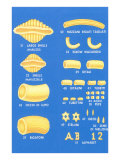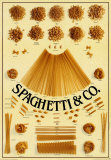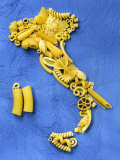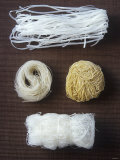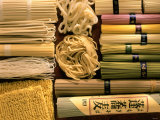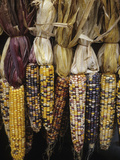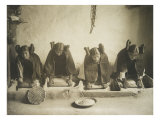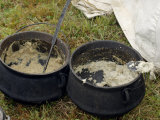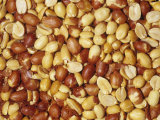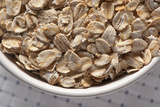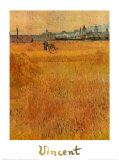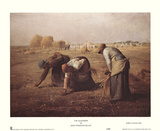|
|
|
|
|
|
|
|
|
|
|
|
|
|
Corn - The precursor plant to what we know as corn today is believed to be a wild grass called teosinte, indiginous to central Mexico, and first cultivated (made part of the culture) about 7,000 years ago.
The wild grass, which has relatively few, small seeds that easily scatter when the plant is touched, was domesticated for traits of larger, easier to harvest seeds.
The domesticated plant and seeds came to be known as maize by the indiginous peoples throughout North and South America, and a major food source.
|
Mealing troughs contained the milling apparatus in pueblo Indian homes. The trough in the photograph is a series of metates (mortar or ground stone tool) that are firmly fixed in a slanted position with partitions between compartments. The metates and manos (hand held grinding stones) range from coarse to fine for crushing maize and reducing it to a fine powder suitable for cooking.
• more Native Americans posters
|
FYI -
Europeans were unaware of corn before the explorations of Christopher Columbus.
Today ground corn is used in many cultures: polenta in Italy; masa in Central America; grits, hominy and mush in the US.
Poet Joel Barlow wrote a poem about cooking and eating “Hasty Pudding”.
Botanist Barbara McClintock's life long work was on the cytogenetics of maize.
Corn as a raw material is used an animal feed (“corn-fed beef”), for creating plastics, and biofuels.
In researching corn I learned something about corn that I didn't know before - Corn is also “a natural pesticide as some insects' digestive organs will swell after consuming cornmeal and water, causing them to die”.
• article - “Does Eating Corn Syrup Kill Your Memory?” - A team of UCLA researchers have observed that rats, fed high fructose corn syrup (HFCS), are more forgetful ...
|
|
|
|
The peanuts, or groundnut (Arachis hypogaea), is a species in the legume “bean” family (Fabaceae).
The cultivated peanut, first domesticated in South America, was found by Europeans in the markets of Tenochtitian (Mexico City) and spread world wide.
African American botanist and agricultural educator George Washington Carver reputedly discovered three hundred uses for peanut (but not peanut butter).
|
|
|
|
|
|
|
|
|
|
|
|
|
|
|
|
|
|
|
|
previous page | top
grains 1 | GRAINS 2
|
|
I have searched the web for visual, text, and manipulative curriculum support materials - teaching posters, art prints, maps, charts, calendars, books and educational toys featuring famous people, places and events - to help teachers optimize their valuable time and budget.
Browsing the subject areas at NetPosterWorks.com is a learning experience where educators can plan context rich environments while comparing prices, special discounts, framing options and shipping from educational resources.
Thank you for starting your search for inspirational, motivational, and educational posters and learning materials at NetPosterWorks.com. If you need help please contact us.
|
|
|







